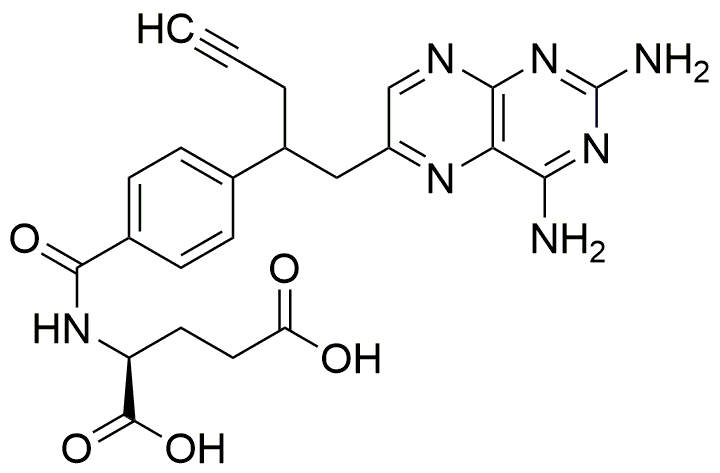Pralatrexate is widely utilized in research focused on:
- Cancer Treatment: Primarily used in the treatment of peripheral T-cell lymphoma, pralatrexate acts as an antifolate, inhibiting cancer cell growth by interfering with DNA synthesis.
- Pharmaceutical Development: It serves as a critical compound in developing new cancer therapies, allowing researchers to explore combination treatments that enhance efficacy and reduce side effects.
- Clinical Trials: Frequently involved in clinical studies, pralatrexate helps evaluate its effectiveness and safety in various cancer types, providing valuable data for oncologists.
- Research on Drug Resistance: Utilized to study mechanisms of drug resistance in cancer cells, aiding in the development of strategies to overcome resistance and improve treatment outcomes.
- Biomarker Identification: Plays a role in identifying biomarkers for patient stratification, helping clinicians tailor treatments based on individual responses to therapy.
Informations générales
Propriétés
Sécurité et réglementation
Applications
Pralatrexate is widely utilized in research focused on:
- Cancer Treatment: Primarily used in the treatment of peripheral T-cell lymphoma, pralatrexate acts as an antifolate, inhibiting cancer cell growth by interfering with DNA synthesis.
- Pharmaceutical Development: It serves as a critical compound in developing new cancer therapies, allowing researchers to explore combination treatments that enhance efficacy and reduce side effects.
- Clinical Trials: Frequently involved in clinical studies, pralatrexate helps evaluate its effectiveness and safety in various cancer types, providing valuable data for oncologists.
- Research on Drug Resistance: Utilized to study mechanisms of drug resistance in cancer cells, aiding in the development of strategies to overcome resistance and improve treatment outcomes.
- Biomarker Identification: Plays a role in identifying biomarkers for patient stratification, helping clinicians tailor treatments based on individual responses to therapy.
Documents
Fiches de données de sécurité (FDS)
La FDS fournit des informations de sécurité complètes sur la manipulation, le stockage et l’élimination du produit.
Spécifications du produit (PS)
Le PS fournit une description complète des propriétés du produit, notamment sa composition chimique, son état physique, sa pureté et les exigences de stockage. Il détaille également les plages de qualité acceptables et les applications prévues du produit.
Certificats d'analyse (COA)
Recherchez des certificats d'analyse (COA) en saisissant le numéro de lot du produit. Les numéros de lot et de lot se trouvent sur l'étiquette d'un produit, après les mots « Lot » ou « Lot de fabrication ».
Numéro de catalogue
Numéro de lot/série
Certificats d'origine (COO)
Ce certificat d'exploitation confirme le pays dans lequel le produit a été fabriqué, et détaille également les matériaux et composants utilisés et s'il est issu de sources naturelles, synthétiques ou autres sources spécifiques. Ce certificat peut être requis pour les douanes, le commerce et la conformité réglementaire.
Numéro de catalogue
Numéro de lot/série
Fiches de données de sécurité (FDS)
La FDS fournit des informations de sécurité complètes sur la manipulation, le stockage et l’élimination du produit.
DownloadSpécifications du produit (PS)
Le PS fournit une description complète des propriétés du produit, notamment sa composition chimique, son état physique, sa pureté et les exigences de stockage. Il détaille également les plages de qualité acceptables et les applications prévues du produit.
DownloadCertificats d'analyse (COA)
Recherchez des certificats d'analyse (COA) en saisissant le numéro de lot du produit. Les numéros de lot et de lot se trouvent sur l'étiquette d'un produit, après les mots « Lot » ou « Lot de fabrication ».
Numéro de catalogue
Numéro de lot/série
Certificats d'origine (COO)
Ce certificat d'exploitation confirme le pays dans lequel le produit a été fabriqué, et détaille également les matériaux et composants utilisés et s'il est issu de sources naturelles, synthétiques ou autres sources spécifiques. Ce certificat peut être requis pour les douanes, le commerce et la conformité réglementaire.


